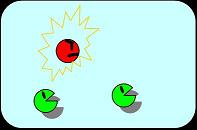Tokyo/Model
From 2007.igem.org
(Difference between revisions)
(→'''Model''') |
(→'''Model''') |
||
| Line 6: | Line 6: | ||
[[Image:model1.jpg]] | [[Image:model1.jpg]] | ||
| - | The system is stable containing nodes A and B at certain ratio. | + | <br>The system is stable containing nodes A and B at certain ratio. |
'''Condition 2. Unstable state with node A removed''' | '''Condition 2. Unstable state with node A removed''' | ||
[[Image:model2.jpg]] | [[Image:model2.jpg]] | ||
| - | Removed of node A, the system contains only node B and becomes unstable. Node B detects the removal of node A from the system and knows that there is only node B left. | + | <br>Removed of node A, the system contains only node B and becomes unstable. Node B detects the removal of node A from the system and knows that there is only node B left. |
'''Condition 3. From unstable to stable state''' | '''Condition 3. From unstable to stable state''' | ||
[[Image:model3.jpg]] | [[Image:model3.jpg]] | ||
| - | In an unstable state, some node B become A while the others remain B. The system then becomes stable again. | + | <br>In an unstable state, some node B become A while the others remain B. The system then becomes stable again. |
Revision as of 16:43, 17 October 2007
Model
To establish a system following Pareto’s principle, the system must satisfy the following three cases. In our model, all nodes have the same genetic circuits and take two states, A (worker) and B (idler), depending on the surrounding circumstances.
Condition 1. Bistable state

The system is stable containing nodes A and B at certain ratio.
Condition 2. Unstable state with node A removed

Removed of node A, the system contains only node B and becomes unstable. Node B detects the removal of node A from the system and knows that there is only node B left.
Condition 3. From unstable to stable state

In an unstable state, some node B become A while the others remain B. The system then becomes stable again.